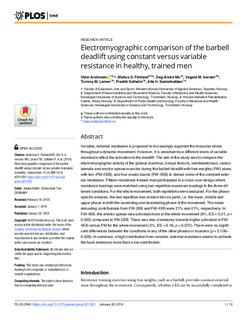| dc.contributor.author | Andersen, Vidar | |
| dc.contributor.author | Fimland, Marius Steiro | |
| dc.contributor.author | Mo, Dag-Andrè | |
| dc.contributor.author | Iversen, Vegard Moe | |
| dc.contributor.author | Larsen, Tommy M | |
| dc.contributor.author | Solheim, Fredrik | |
| dc.contributor.author | Sæterbakken, Atle Hole | |
| dc.date.accessioned | 2019-05-09T09:01:16Z | |
| dc.date.available | 2019-05-09T09:01:16Z | |
| dc.date.created | 2019-03-05T18:54:40Z | |
| dc.date.issued | 2019 | |
| dc.identifier.citation | Andersen, V., Fimland, M. S., Mo, D.-A., Iversen, V. M., Larsen, T. M., Solheim, F., & Sæterbakken, A. H. (2019). Electromyographic comparison of the barbell deadlift using constant versus variable resistance in healthy, trained men. Plos One, 14(1). | nb_NO |
| dc.identifier.issn | 1932-6203 | |
| dc.identifier.uri | http://hdl.handle.net/11250/2597079 | |
| dc.description.abstract | Variable, external resistance is proposed to increasingly augment the muscular stress throughout a dynamic movement. However, it is uncertain how different levels of variable resistance affect the activation in the deadlift. The aim of the study was to compare the electromyographic activity of the gluteus maximus, biceps femoris, semitendinosus, vastus lateralis and erector spinae muscles during the barbell deadlift with free weights (FW) alone, with two (FW-2EB), and four elastic bands (FW-4EB) to deload some of the constant external resistance. Fifteen resistance-trained men participated in a cross-over design where resistance loadings were matched using two-repetition maximum loadings in the three different conditions. For the whole movement, both repetitions were analyzed. For the phase-specific analysis, the last repetition was divided into six parts, i.e. the lower, middle and upper phase in both the ascending and descending phase of the movement. The mean deloading contributions from FW-2EB and FW-4EB were 21% and 41%, respectively. In FW-4EB, the erector spinae was activated more in the whole movement (8%, ES = 0.31, p = 0.002) compared to FW-2EB. There was also a tendency towards higher activation in FW-4EB versus FW for the whole movement (5%, ES = 0.18, p = 0.072). There were no significant differences between the conditions in any of the other phases or muscles (p = 0.106–0.926). In summary, a high contribution from variable, external resistance seems to activate the back extensors more than a low contribution. | nb_NO |
| dc.language.iso | eng | nb_NO |
| dc.publisher | PLoS | nb_NO |
| dc.rights | Navngivelse 4.0 Internasjonal | * |
| dc.rights.uri | http://creativecommons.org/licenses/by/4.0/deed.no | * |
| dc.title | Electromyographic comparison of the barbell deadlift using constant versus variable resistance in healthy, trained men | nb_NO |
| dc.type | Journal article | nb_NO |
| dc.type | Peer reviewed | nb_NO |
| dc.description.version | publishedVersion | nb_NO |
| dc.rights.holder | © 2019 Andersen et al. | nb_NO |
| dc.subject.nsi | VDP::Medisinske Fag: 700::Idrettsmedisinske fag: 850::Treningslære: 851 | nb_NO |
| dc.source.pagenumber | 12 | nb_NO |
| dc.source.volume | 14 | nb_NO |
| dc.source.journal | PLoS ONE | nb_NO |
| dc.source.issue | 1 | nb_NO |
| dc.identifier.doi | 10.1371/journal.pone.0211021 | |
| dc.identifier.cristin | 1682497 | |
| cristin.unitcode | 203,10,1,0 | |
| cristin.unitcode | 203,0,0,0 | |
| cristin.unitname | Institutt for idrett, kosthald og naturfag | |
| cristin.unitname | Høgskulen på Vestlandet | |
| cristin.ispublished | true | |
| cristin.fulltext | original | |
| cristin.qualitycode | 1 | |

